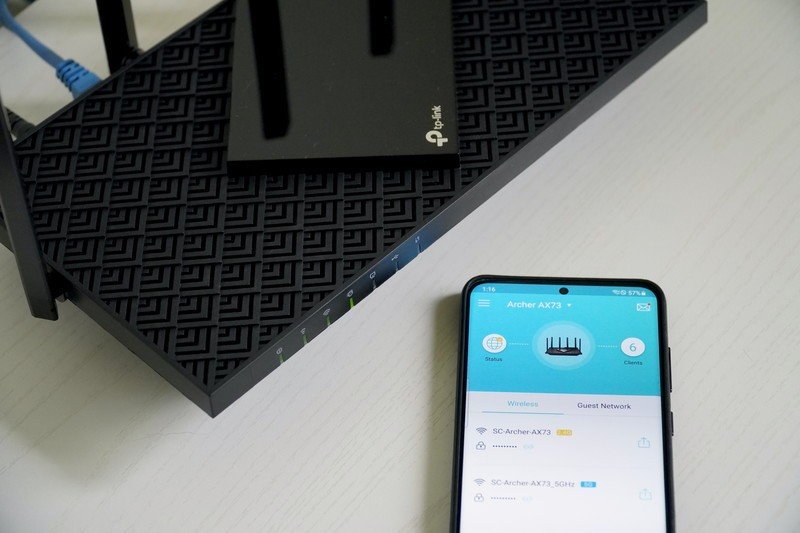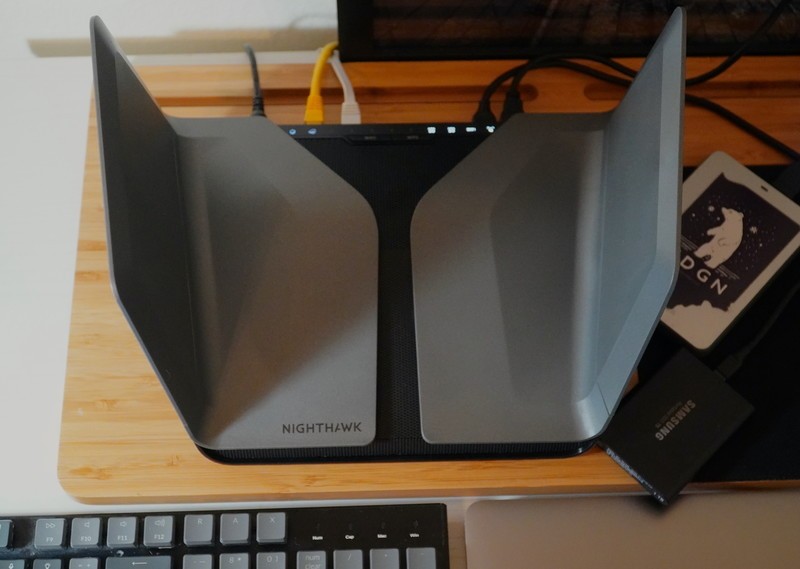Android Central Verdict
Bottom line: The TP-Link Archer AX73 is a fast router with AX5400 speeds, Wi-Fi 6, and 160MHz support in a compact housing. The fan-free design looks nice enough to keep out in the open, and coverage is solid enough for most medium to large homes.
Pros
- +
Great speeds with AX5400 and 160MHz
- +
Easy setup with Tether app
- +
HomeShield offers decent parental controls and security for free
- +
Great price for this level of router
Cons
- -
Random connection drops during testing
- -
No multi-gig Ethernet
- -
HomeShield's full features require a subscription
Why you can trust Android Central
The TP-Link Archer AX73 gets all of the specs right on paper with a fast AX5400 Wi-Fi 6 connection, USB 3.0, and Wi-Fi 6 support. It supports MU-MIMO, OFDMA, 160MHz, and DFS for extra 5GHz channels. The design is nice and compact, and the coverage is reasonable for the price, but some connection issues keep me from completely recommending this router, especially if you plan to connect a lot of devices.
The Archer AX73 is easy to set up and works well with the TP-Link Tether app. This also includes HomeShield for free parental controls and basic security options with the ability to subscribe for more. If you're looking for one of the cheapest fast WI-Fi 6 routers around, the Archer AX73 makes all of the right sacrifices for most people.
TP-Link Archer AX73: Price and availability

The TP-Link Archer AX73 is a newer model released in early 2021 with a suggested price of $199.99. This router hasn't reached all of TP-Link's markets yet, but some like Canada, India, the U.K., and the U.S. have already had releases. This router will likely be released to all countries TP-Link has business though performance will vary a bit by region. This is due to spectrum availability in different countries. Still, for most people, the speeds will be close enough in any region.
TP-Link Archer AX73: What's good

Like most TP-Link routers, the easiest way to set up and manage the Archer AX73 is with the Tether app. This app makes it easy and fast to get your network set up and online, though if you want finer controls, you'll need to adjust them in a web browser. Helpfully, there's a link to the configuration page under the advanced settings option in the Tether app.
The web browser interface is well-designed and easy to use, so it was no trouble getting my settings exactly as I wanted them.
The web browser interface is well-designed and easy to use, so it was no trouble getting my settings exactly as I wanted them. By default, the 5GHz channel was set to 80MHz but could be configured to 160MHz without any issue. Smart Connect is available to unify both the 5GHz and 2.4GHz channels under a single name but isn't optimized to give you the most speed possible. With smart connect, my devices only had a link speed of 600Mbps. This is fine for most standard usage, but to see what this router can do, I needed to split up my bands and configure them for full speed.

My internet connection is from Cox with 500Mbps down and 10Mbps up. The upload speed is so slow that every test point was able to keep up without breaking a sweat. My desktop with an Intel AX210 Wi-Fi card had a link speed of 2.4Gbps and had no trouble getting full internet speed from its fixed location fairly near to the router.
Wi-Fi speeds held up pretty well across the rest of my home.
2.4GHz results (two tests):
| Device | Living room (router) | Front room | Bathroom |
|---|---|---|---|
| LG V60 | 111 Mbps105 Mbps | 102 Mbps96.5 Mbps | 82.1 Mbps75.2 Mbps |
| Galaxy S20+ | 105 Mbps108 Mbps | 87.4 Mbps65.5 Mbps | 78.5 Mbps63.9 Mbps |
| LG G8 (Wi-Fi 5) | 108 Mbps110 Mbps | 86.8 Mbps62.8 Mbps | 67 Mbps69 Mbps |
| iPhone 11 Pro | 119 Mbps126 Mbps | 80.9 Mbps80.5 Mbps | 90.9 Mbps79.2 Mbps |
The difference between an AX5400 router and an AX6000 router is the 2.4GHZ speed which is cut in half. The two of this router's six streams are dedicated to 2.4GHz band compared to the four of eight typical in an AX6000 router like the Netgear Nighthawk RAX80. Still, with so many devices supporting 5GHz, there's not that much reason to focus on it unless you have numerous 2.4GHz-only Wi-Fi devices in the same area. This will cause the speeds to plummet quickly.
If you're using most 5GHz devices, though, the speeds are great, and keep up with much more expensive routers.
5GHz results (two tests):
| Device | Living room (router) | Front room | Bathroom |
|---|---|---|---|
| LG V60 | 573 Mbps551 Mbps | 492 Mbps531 Mbps | 513 Mbps494 Mbps |
| Galaxy S20+ | 582 Mbps585 Mbps | 569 Mbps554 Mbps | 541 Mbps535 Mbps |
| LG G8 (Wi-Fi 5) | 523 Mbps503 Mbps | 411 Mbps446 Mbps | 386 Mbps330 Mbps |
| iPhone 11 Pro | 530 Mbps521 Mbps | 537 Mbps554 Mbps | 437 Mbps410 Mbps |

I like the way the Archer AX73 looks. Following the design language introduced with the entry-level Archer AX21, one of the best cheap Wi-Fi 6 routers you can get, the Archer AX73 has an angular flat top with plenty of ventilation to keep it running reasonably cool. I'm not a fan of the USB port's placement on the side, but everything else feels well thought out.
If you want to mount this router on a wall, there are mounting holes, and the antennas can be adjusted for optimal performance. If you are mounting this router, remember that it is passively cooled, and you should leave enough breathing room above it for the heat to dissipate.
TP-Link HomeShield is a standout value on the Archer AX73 as it was on the Archer AX90. HomeShield comes with parental controls with profiles and content blocking. HomeShield also includes the QoS options as well as some real-time security enhancements. HomeShield has a nice feature that will scan for issues on your network, including security and network performance. If you're set to a channel with interference, for example, it can recommend a better option.


Source: Samuel Contreras / Android Central
The Archer AX73 is also compatible with Amazon Alexa.
This router has a USB 3.0 port that works with most storage devices, including Mac and PC formats. The device appeared immediately as a network drive and was quick and easy to connect to. Mac users can also set a drive as a Time Machine backup location, and it will show up in the Time Machine settings. If you're not already backing up your Mac, this is an easy way to get set up, and you never have to plug a USB drive into your laptop.

TP-Link Archer AX73: What's not good

HomeShield comes with some nice features for free, but if you want the full package, you'll need to pay. HomeShield costs either $5.99 per month or $54.99 per year. You get the most important stuff with the basic package, but with the older HomeCare software, including many of the excluded features on older TP-Link routers, it feels like a worse value. If you're used to HomeCare, keep in mind that there are some key differences with HomeShield.



Source: Samuel Contreras / Android Central
The Archer AX73's biggest fault by far was the dropped connections. Twice during my testing, the AX73 dropped about half of my 5GHz devices, and they did not reconnect automatically. Admittedly I was changing a lot of settings before this happened, and the router was being stressed with a dozen new connections in a short period, but this hasn't happened to me on any other routers. I put the settings where I wanted them and left the router alone for a while. I haven't had the issue in the several days since, but it still doesn't bode well, especially for heavier users.
There are reports of similar issues on TP-Link's help forums for several of its Wi-Fi 6 models, though not that many. There's a good chance you'll never have a single problem, but if you buy this router and it isn't performing as you need it to, don't hesitate to return it.
If you were looking to push this router to the limits with heavy traffic or a lot of devices, you should hold off for now and consider something from the competition. Hopefully, TP-Link will be able to improve the consistency of this router with a software update. It's not the first router to launch with connection issues, so there's hope, but you should never buy a tech product on the chance of a fix.
TP-Link Archer AX73: Competition

The Asus RT-AX82U is an AX5400 router from Asus with similar Wi-Fi 6 specs but a focus on gaming. The AX82U includes AiProtection Pro security and parental controls, gaming optimization with a dedicated gaming port, and specific gaming optimization setting in software. With a suggested price of $229.99, this router isn't much more expensive than the TP-Link Archer and might be a better fit for you, especially if you're a gamer.
The Netgear Nighthawk RAX80 has a slight hardware advantage with AX6000 speed and eight instead of six streams. This means it will keep up with more simultaneous connections than the Archer AX73. It also comes with Circle Parental controls basic, which offers a similar level of control to HomeShield. The RAX80 is significantly more expensive than the AX73, with a price of $399.99, but the extra performance will be worth it to some.
TP-Link Archer AX73: Should you buy it?

You should buy this if ...
- You want fast Wi-Fi 6 speeds for less than the competition
- You want Alexa integration in your router
- You need included parental controls
- You want a compact Wi-Fi 6 router with adjustable antennas
You shouldn't buy this if...
- You are a heavy user that demands 100% uptime
- You need more advanced security and parental controls for free
At the end of the day, this is a solid router with some compromises to hit one of the most compelling price points for a router with this speed. Staying in control is easy with built-in parental controls and Alexa integration. You can even mount and adjust it as needed. Still, the disconnection risk makes it a bad choice for someone that fully relies on their connection and can't have any downtime.
3.5 out of 5
There is no ignoring random disconnects on a router. Even so, I haven't been able to replicate the drops, and the router has performed admirably since I've left it alone. Still, it's just not ready for heavy users that rely on their connections if it can't guarantee perfect uptime outside of internet connection issues and power cuts. If you need that absolute uptime, though, you should consider a router that has been out longer with more mature software.
TP-Link is so close to a winner with the Archer AX73. The speeds are fast, and the coverage is adequate for most homes. At a price that undercuts the majority of the competition, there's not much you can do to go faster for less. The USB options are also great, with some bonuses for Mac users. If you need a Wi-Fi 6 router with full 160MHz support, easy setup, and parental control bonuses, this is still a solid choice.
When Samuel is not writing about networking or 5G at Android Central, he spends most of his time researching computer components and obsessing over what CPU goes into the ultimate Windows 98 computer. It's the Pentium 3.


